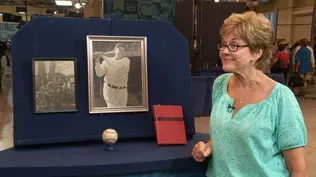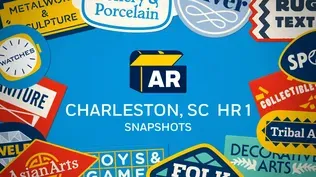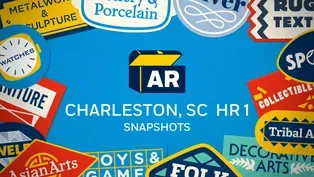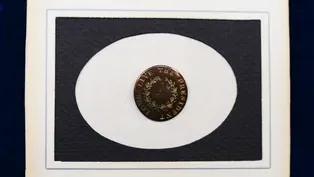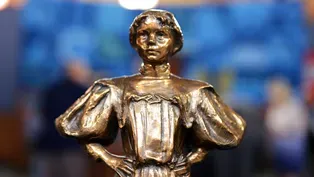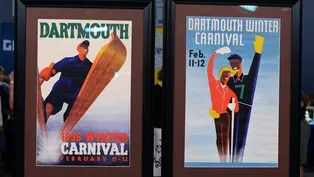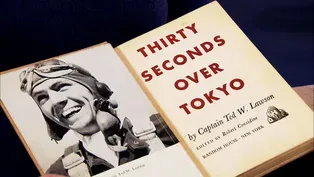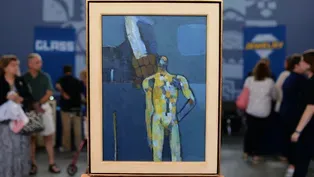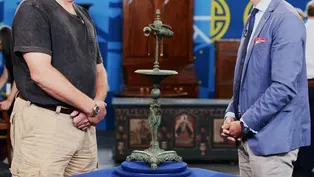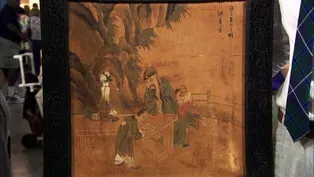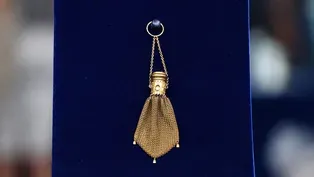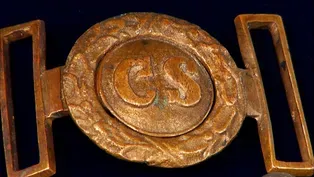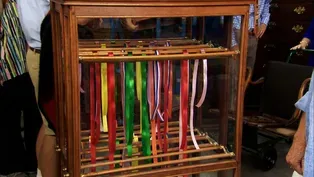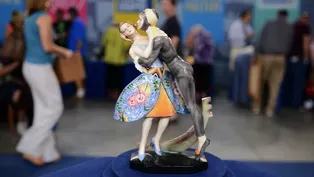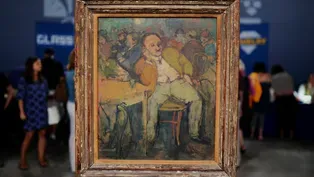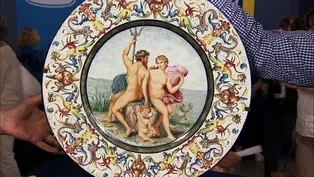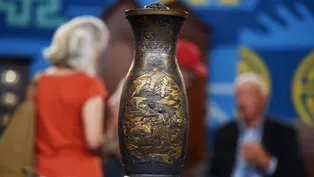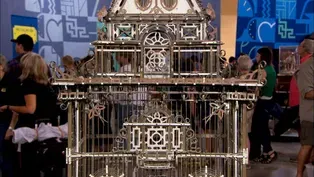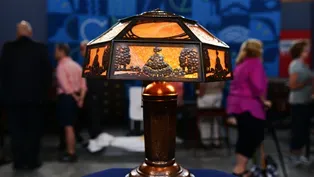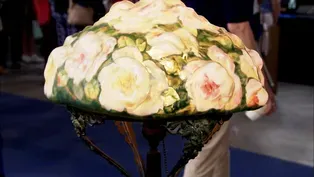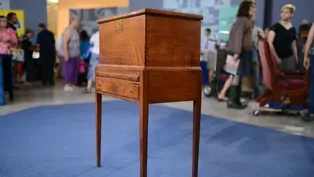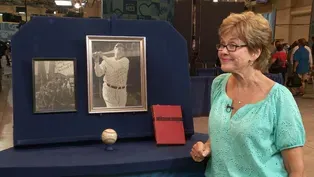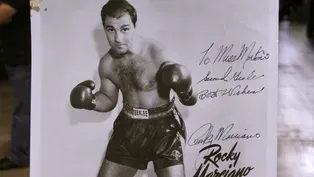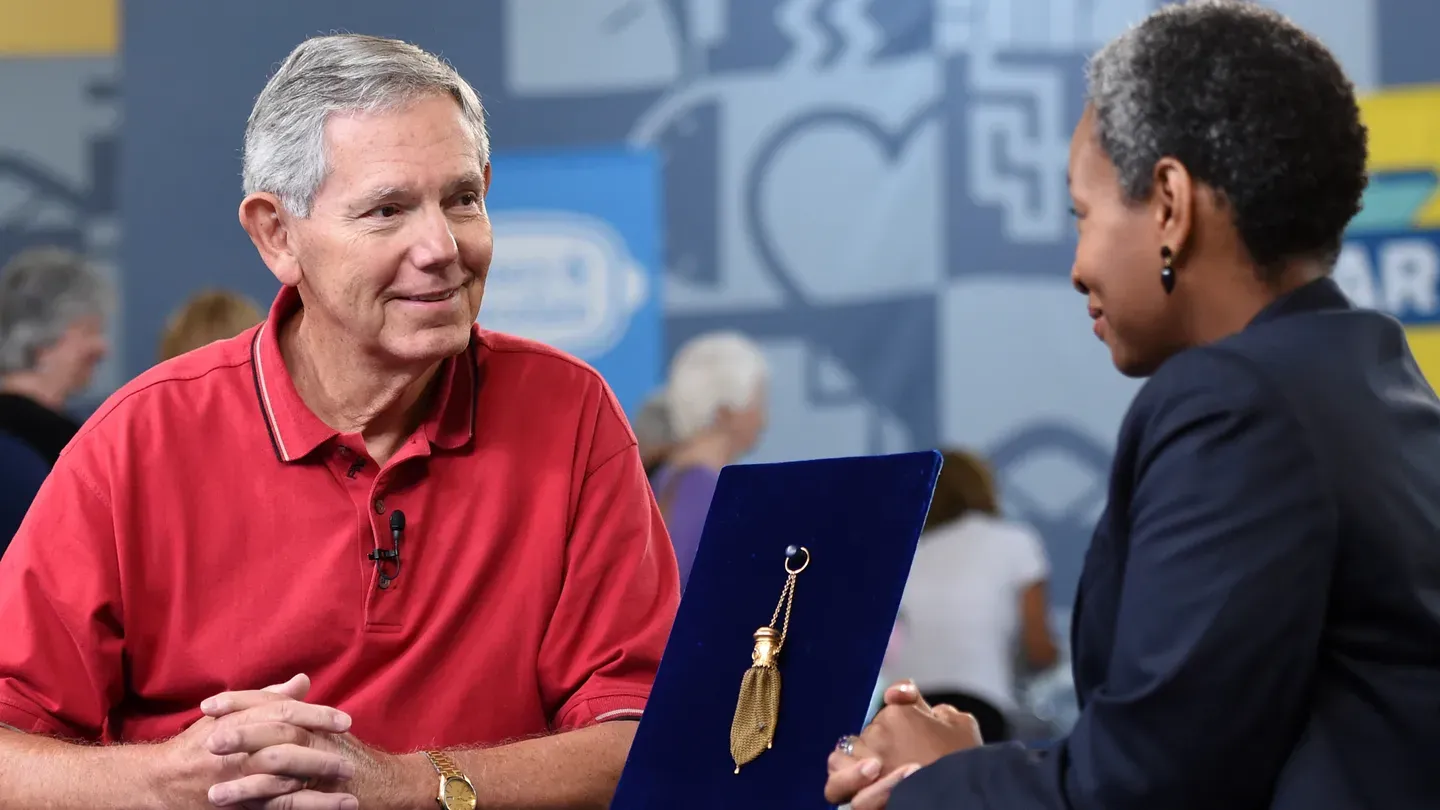

Charleston, SC, Hour 1 (2016)
Season 20 Episode 7 | 53m 1sVideo has Closed Captions
A Babe Ruth archive, a Japanese Komai vase, and a Virginia cellarette. One is $80K-$100K!
Travel with ROADSHOW to Charleston, SC and learn about a Babe Ruth archive, a Japanese Komai iron & gold vase from around 1890, a Virginia Federal walnut cellarette, and more.
Problems with Closed Captions? Closed Captioning Feedback
Problems with Closed Captions? Closed Captioning Feedback
Funding for ANTIQUES ROADSHOW is provided by Ancestry and American Cruise Lines. Additional funding is provided by public television viewers.

Charleston, SC, Hour 1 (2016)
Season 20 Episode 7 | 53m 1sVideo has Closed Captions
Travel with ROADSHOW to Charleston, SC and learn about a Babe Ruth archive, a Japanese Komai iron & gold vase from around 1890, a Virginia Federal walnut cellarette, and more.
Problems with Closed Captions? Closed Captioning Feedback
How to Watch Antiques Roadshow
Antiques Roadshow is available to stream on pbs.org and the free PBS App, available on iPhone, Apple TV, Android TV, Android smartphones, Amazon Fire TV, Amazon Fire Tablet, Roku, Samsung Smart TV, and Vizio.
Buy Now

ANTIQUES ROADSHOW 2025 Tour!
Enter now for a chance to win free tickets to ANTIQUES ROADSHOW's 2025 Tour! Plus, see which cities we're headed to!Providing Support for PBS.org
Learn Moreabout PBS online sponsorshipMARK WALBERG: Antiques Roadshow was glad to be back in beautiful Charleston, South Carolina.
We've had it about six years.
I actually use it as a file cabinet.
(laughing) Oh, my gosh!
(laughing) ♪ ♪ WALBERG: Antiques Roadshow's return to Charleston included a stop at the oldest public building in South Carolina, the Powder Magazine.
Completed in 1713, this Colonial era landmark periodically served as an arsenal until 1820.
However, there was a time in its past when the Powder Magazine was used for wine storage.
Back at the Roadshow, this Southern treasure might have been a good place for some of that wine.
Check it out.
WOMAN: Well, it belonged to my husband's grandmother, and we've had it about six years.
I actually use it as a file cabinet.
(laughing) We really didn't know what it was.
A friend of the family said, "I think that's a sugar chest," and that's the only thing I know about what it could be.
Files fit great in it, so...
Okay, so part of the way to figure that out is to look at the inside, and before I open it, notice this beautiful single-board walnut top with these batten ends, this beautiful color, but inside, let's see if we get any clues in here.
It's just an empty box, right?
Yeah.
There's nothing in there.
If this had been a sugar chest, it would have been slightly different in that it would have had usually two dividers.
Sugar came in cones, and they would have divided it into maybe three sections inside.
So we've just got this empty box, and there are no scars on the side where it had mortises or anything.
But if you look very closely on all four sides, there's one single nail hole.
Originally, when this was made, it likely had a frame there that would have had dividers for bottles.
So this was for the family liquor.
Oh!
So this is a cellarette rather than a sugar chest.
Both of those are generally considered uniquely Southern forms.
The piece is made of walnut top to bottom.
It's very finely made.
It has beautiful dovetails on the side and on the drawers.
It has period hinges on the back with beautiful rosehead nails on them.
So the piece itself is fairly intact.
It does have some things that have happened to it over the years.
The brass plate here that covers the escutcheon is a later replacement.
There's an odd little patch on your side over there.
Maybe it got a gouge in it or something.
It's a very shallow patch.
So it's not flawless, but really, it's very intact, which is unusual.
This piece would date to maybe 1800 or 1810.
So over those 200-plus years, these beautiful, delicate, tall legs, which is part of what really is the magic of this piece, are all intact.
Southern cellarettes tend to be very consistent in their design, and there are pieces like this that have been attributed to a maker in Gates County, North Carolina, which is just on the North Carolina side of Virginia.
And there are also Virginia cases that have been attributed to other makers or unknown makers.
Either way, it's somewhere in that line.
Given the family history in Richmond, I'm inclined to put it on the Virginia side.
But this is an object that is prized by collectors.
So it came down through the family, and it really is pretty special.
At auction, I would expect this piece to bring maybe between $12,000 and $18,000.
Oh, my gosh!
You're kidding!
So this really is... it's a great object.
Oh, my gosh!
So don't break a leg, don't put too many files in it.
I can't put my files in this now!
You can!
It's there to be used.
But I would just put the important files, maybe the thin files in it.
Oh, my gosh!
MAN: My mother passed away in 1980, and we inherited this.
She was originally from New York City, grew up in New York City.
Her grandmother lived there, and this belonged to her grandmother.
It's a decorative purse, actually, with, we think, an amethyst stone on it.
My mother said her grandmother referred to it as her Mad Money purse.
Well, let me tell you what I know about your object.
Okay.
It is 14-karat yellow gold.
The mesh is in extremely good condition.
Usually, these have tears or it's broken, and yours is completely intact, which is wonderful to see.
It is a change purse.
This is probably late 1890s, part of the Gilded Age, if you would think about that, or late Victorian, depending on where you are.
And it is in fact an amethyst on the top, and I'm going to show you that.
The amethyst is actually about ten carats, right up there.
The cool thing about your object is that it opens.
And then you can pull it open slightly and it expands, so you can actually get coins in there if you wanted.
And this is also in really good shape because normally, these rivets are broken.
Okay.
Right on the top, it's stamped "14 karat" for the gold, so 14-karat yellow gold, but you also have a little hallmark, and this is for Carter, Gough Company, and they were from Newark, and there were lots of jewelers in Newark making exceptional jewelry.
And this is just a beautiful example of late Victorian Gilded Age jewelry.
Do you have any idea of its value?
No, I don't.
If it's 14-karat gold, obviously it has a gold value, but no, I don't.
Similar examples, retail, are between $5,000 and $7,000.
Ah.
Hoo-hah!
Hoo-hah, I love it.
Hoo-hah!
♪ ♪ If it hit something, it would break for sure.
Ready?
We're going to have more pictures of this one.
(laughing) WOMAN: My husband's mother was an Irish immigrant, and she worked as a governess in the homes of many wealthy families in New York City.
Our best bet is that she was given this as a gift from one of those families.
And it's lived in basements for decades.
We don't know a lot about its history at all.
We think perhaps it was a hand-crafted birdcage-- that was pretty much all my husband remembers her ever saying about it.
Well, clearly hand-crafted.
Someone had a lot of time on their hands and put a lot of effort into this.
I would date this to the 19th century.
Wow.
High Victorian style.
This almost weird combination of architectural styles.
You have Greek classical, you have this mansard roof, you have a widow's walk.
It's also a penthouse, so it has a lot going on architecturally.
The other thing that's interesting to me is the number of metals that are used.
There's tin, there's copper, there's aluminum, this is brass at the corners.
It probably had a little bit more paint on it originally, and you can see some remnants of it in the grating on top and in some of the window and wire work.
We don't know who made it.
Right.
We do know the time period, and we have an idea of what it's made out of.
Bird keeping is not all the rage that it was, but these are highly decorative and highly sought after.
I think we'd be looking at about a $5,000 value retail.
Really?
Oh, that's very interesting and good news.
In the early 1990s, I opened a restaurant in downtown Charlotte, North Carolina.
A lot of my customers worked for the banks uptown, and one of them told me there was an auction on Saturday at 10:00.
It benefited the AIDS Foundation.
And this was the first picture that came up.
The fella's estate, he was a musician who'd collected a lot of art.
The first painting came up and they said it's worth between $10,000 and $12,000, and that's almost like insider trading when they tell you that.
But they started the auction at $7,500, there was no bid, dropped to $7,000, 65, 60, 55.
It got down to $1,000, and they said, "Now listen, this is a listed artist.
"His paintings are bringing in a good price.
Let's start the bidding now."
And they started at $900, nobody bid, eight... My wife said, "Why don't you bid on it?"
and I said, "Well, there's nobody bidding against us," so it got down to two, and I started the bidding at two, and another person joined in at two and a quarter, and immediately, I went to three and a quarter and ended up getting it with the buyer's premium for $350.
As an auctioneer, that story pains me.
You do not want to go backwards.
What do you know about the painter?
We know he's English, it's signed "1957."
We like the colors.
I've gone online with my wife and we've looked.
His paintings, you know, are still appreciated by a lot of people.
Well, it's by Keith Vaughan, and it's oil on masonite.
Keith Vaughan is a British modern painter.
This picture is from 1957.
The sticker on the back also gives us the title, "Bather."
And stylistically, we know the picture is within a few years of 1957 even without that information.
He was a conscientious objector in World War II, and that's when he really sort of started doing his art.
He was a self-taught artist, but was discovered pretty early.
Right after the war, he was part of an important movement called the Neo-Romantic Movement, but very briefly.
He very quickly went off in his own direction, and it was pictures like this-- they were often male figures, and usually, they would verge into abstraction, and they got more abstract over the years.
He's an interesting story and kind of a sad story, and I think it echoes to some extent what you were talking about.
The musician who passed away, whose sale was to benefit AIDS, Vaughan was, and we know this from his journals, was a very troubled, maybe even a bit tortured man, and at the root of that was his sexuality.
Unfortunately, in 1975, he was diagnosed with cancer and sadly, in '77, he took his own life.
And he was successful, but also withdrawn, and he never really saw how much this market would take off.
I would suggest that this painting conservatively is worth $40,000 to $60,000 at auction.
Fantastic.
Well, I have a Babe Ruth ball, a picture of Babe Ruth from a hunting camp that he used to attend in Havelock, North Carolina, and an autographed picture of him to his good friend Ellis Simon, who was our family friend.
And when did the items pass to you?
Probably 1983, when Ellis passed away and he left us in his will.
Now of course, Ellis Simon, with his hunting lodge and the fishing on the lake, a lot of ballplayers came and attended his resort.
Right, exactly, and Ted Williams was there too, and we have some of that memory.
Ted Williams was a big hunter and fisherman too.
Yep.
And so tell me about the baseball.
Well, it's signed by several All Stars, or Hall of Famers, 12 signatures in all.
And we presume these would have been players that came and attended, or visited, the hunting lodge.
I'm not sure about that.
I know that one of the players was a player in my hometown, where he's from, Kinston, North Carolina.
And he acquired this ball and therefore passed it on.
Right, and so we have 12 signatures total on the ball, including of course Babe Ruth, as we can see, and Dizzy Dean, Dazzy Vance, Lefty Grove, Frank Frisch, Joe Medwick, and Pepper Martin, among others.
And then the book, tell me about the book.
It was given to Ellis by Babe, autographed in the front.
It is a first edition, and then we open it up and here we have, "To Ellis Simon, from Babe Ruth," a beautiful fountain pen signature there on this signed first edition.
Then of course the hunting photo we have there with Babe and all the game there.
And then let's talk about the large photo here.
So it's personalized to Ellis, which is okay.
It's nice to see that this is personalized.
In the personalization, he writes, "To my friend Ellis Simon," and then it said, "In fond memory of Camp Bryan, collards, and Craven County corn."
So tell me about Craven County corn.
I think that was just his way of saying, "Good whiskey."
So here, the Babe still has a sense of humor about that, even though here, dated May 20, 1948, he passed away less than three months after he signed this photo.
Another thing that's interesting about the photo is this was taken on the set of the Lou Gehrig biopic, The Pride of the Yankees.
So this was taken during shooting of the movie.
It's a great group with excellent provenance, and we'll start with the book here, a signed first edition.
Has a little bit of wear, and we don't have a dust jacket, so the value on this we would put at auction of $5,000.
Next, we have the baseball.
That one, we would put an estimate at auction of $15,000 to $20,000.
Wow, nice.
The hunting scene photo, of course that's not in Babe's hand-- that's actually noted on the top that it was Babe Ruth at Camp Bryan, Havelock, North Carolina-- but in somebody else's hand.
But still an interesting photo, especially with the relation to the hunting camp.
That one, we put a value of about $300.
Okay.
And lastly, the beautiful, large, signed Babe Ruth photo here.
We'd put a value of that at auction of $15,000 to $20,000.
Wow.
Great.
Thank you.
My husband's aunt Shenevra and great-uncle Frank were married in 1915, and after they were married, they went shopping in Toledo, Ohio, and my husband's great-aunt saw this lamp and she fell in love with it.
Her husband told her then maybe they should buy it, and she said, "No, it is too expensive," and it cost $32.50 at that time.
And so they went back home.
Her husband liked to spoil her, so he thought that he'd go back to Toledo and purchase the lamp.
You can imagine how excited she was when he came in with the lamp.
I think he sounds like a very good, loving husband, spoiling his wife.
I think he was.
So who do you think made this lamp?
I am not sure.
Really, we don't know any more about it than it was purchased in Toledo, Ohio.
And you did show me the invoice, and it didn't list a maker.
And one of the reasons it didn't list a maker is probably because it's not signed.
However, this is a great Arts and Crafts lamp, and it was definitely made circa 1915.
I conferred with some of my colleagues, and we feel quite certain that this was made by Limbert.
The Charles P. Limbert Company was based both in Grand Rapids, Michigan, and Holland, Michigan.
Oh!
And most of these weren't signed anyway, so you have to know what you're looking for.
This is a particularly nice example because you have all these inset pieces of sunset orange glass.
And usually, these are replaced over the years-- they get damaged, they're replaced.
Every single piece of glass in this is original.
It has this beautiful metal overlay, all intact, no pieces missing, wonderful hammered copper finish on the base.
Fortunately, nobody cleaned it.
It also has the original sockets, it has the original pulls.
And a lamp like this in this condition in today's market, the retail value would be $3,000 to $4,000.
Oh, my!
I never dreamed that it was worth anything like that.
♪ ♪ Beautiful, look at that.
It just kind of has a well-loved condition to it.
It just does.
The scalloped edges are in good shape.
WOMAN: Well, my friend Kim inherited her great-aunt Harriet's estate, and I helped her go through it.
We sold some of it, and I helped her sell it and I helped her ship it out, and she told me I could pick something, and so I asked her for this.
Do you have any idea on this?
Well, I think it's Italian.
It's got "Italian" written on the back of it.
You're one for one.
It is definitely Italian.
And this is actually sort of an homage piece to a very important era in Italian art, the Renaissance era.
And this was made in the latter half of the 1800s, probably around 1880 or so, and it's in an era called the Renaissance Revival.
And this is typified by these really sort of Raphaelesque borders that you have here.
And then you have this enormous interest in Classicism in the middle.
Now, this is a big, super showy piece, and it has this really interesting way that it's actually held together here with the...
The pencils, yes.
This is the greatest "make do" wire ever.
It's like, "We're going to use a pencil to do this."
There's that nice label there, no marks on the back that you can see, but not surprising.
It's very typical of Italian pottery from this time period.
Any idea what it's worth?
No, we don't have a clue, don't have a clue, so... At auction, you would expect this to bring around $1,800 to $2,000.
Oh, really?
That's... (laughs) Well, okay, we're going to have to have a party.
WOMAN: I think it's a candle box.
I bought it recently.
At a shop or something?
At an antique mall.
The asking price was $35, and I got a ten percent discount, so I paid $31.50.
It is, in fact, a candle box.
We have a painted box with a sliding top.
So here on the side, we have this wonderful, really explosive basket of flowers.
It is this really creative American floral motif that's coming out of somebody's mind, right?
Right.
In the 19th century, okay?
That folk appeal, that raw combination of colors, makes it powerful as folk art.
On the top is the same basket, of course, but it's covered with dust because dust settles on a horizontal surface.
It's a sliding top, and that's typical of candle boxes.
And the thing is, at this point in the early 19th century-- this box was made about 1830, 1845, right in that period-- they were still using tallow.
It was made of animal fat.
And mice, those little critters, mice really loved to get at that animal fat, so they had to be in a box somewhere where it's sealed up, and the sliding top actually sealed it.
I didn't know that!
That's great.
I've seen candle boxes with the corners chewed with holes in them.
If we turn it around and see the end of it, I love this color here, this single flower coming up, and you have the yellow band around it, right?
And the interesting thing, I found this fascinating, is that that back side is not painted.
Right.
We don't think that it was ever painted.
I mean, you can see, if we go to the other end, that this board, this exact board has paint on it, it's not a replaced board.
But the one thing is that it makes sense as, like, "Why bother?
That's up on the wall."
What's powerful about folk art is that it's by untrained artists, it has the appeal, the brightness, and this would brighten up a room.
What do you think it's worth?
I mean, you paid $31.50.
Maybe double your money?
$400.
That's a good guess, but I'd multiply that by ten.
Yeah.
Oh, my gosh!
(laughing) Oh, my gosh!
I know!
(laughing) Wow!
You're going to be having piña coladas with your friends tonight.
Yes, we are!
So an auction estimate on this painted Pennsylvania box would be $3,000 to $4,000.
Oh, that's wonderful!
On a good day, it could bring $5,000.
That's fantastic!
I brought this lovely young lady with me.
We've had her in the house for 60 years.
She was given to my husband and I as a gift when we got married.
And I don't know very much about her, but I love her, and she's waited all this time for people to really notice her.
It's a long time not to know anything more about her.
Right.
Did you ever give her a name?
Well, we call her Bessie now.
And why do you call her that?
Well, I saw the artist's name, so I cheated a little bit.
That's all right, that's a good name for her.
Do you know anything at all about the artist?
I don't know anything about the artist, no.
The artist's name is Bessie Potter Vonnoh, and she was born in St. Louis, Missouri, in 1872.
Her father died when she was quite young, and so her mother moved to Chicago, where Bessie enrolled in the Chicago Art Institute, and she studied art there.
And so she became a very good, accomplished artist and ended up working in bronze.
So as sweet as her face is and as beautiful as she is on the front, if we turn her around on the back, she's equally as pretty on the back.
The folds in her dress are so alive, and the folds in her skirt and the sleeves.
You've got that beautiful ponytail with the nice bow in it, and you've got a little bit of a cinched waist with a bow there.
And then you see the signature for the artist.
You so fondly called the bronze Bessie after the artist's name, but it's marked "Bessie Onahotema Potter."
She married in 1899 to an artist who was an impressionist painting artist named Robert Vonnoh, and this is dated 1895.
It also has on the back the Roman Bronzeworks foundry mark, which indicates where she had this casting done, and it has a number one, edition of one on there, so we don't know if that means this was the first of others that were ultimately done or just the one and only example, and we can't find another one just like this ever having been offered at auction.
Wow.
So if we were to value this, I would say, at auction, I would put this in the range of $15,000 to $25,000.
My goodness!
My mother was a lifelong student of, collector of, and eventually a dealer of antiques.
She found this, and she was intrigued by it because she looked at the fringe and saw that there was some sort of bark woven into the fringe, so she said, "I think this is probably an authentic old blanket."
Fast-forward maybe eight or nine years later, I'd bought my first house, she brought it up to my house.
She said, "I think this would look good hung on your wall."
Well, we put it, tried it here, tried it there, it didn't work anywhere, so she took it home, put it into a cedar chest, and that's where it's been ever since, since 1985.
I remember asking my dad about it, and he told me what she paid for it.
And what was that?
What did she pay?
$35.
It's quite a find.
It is the work of the Natives of the Pacific Northwest Coast-- to be more specific, the Tlingits.
It is a weaving tradition that started in the early 1800s.
This piece was probably from the 1910, 1920 time period.
A person who studies Chilkat blankets extensively could probably tell us who the maker was.
Both men and women are involved with the production of these blankets.
The men gather the mountain goat which that's woven of, and the women gather the cedar bark.
Cedar.
It's cedar bark, yes.
It's hung on a horizontal loom, and all the warp fringes hang down.
Each clan has a totem-- bear, frog, beaver... Whoever designed this for, whoever it was made for, this is their animal, which appears to be a bear, predominately, broken up and spread on a symmetrical display.
They were always very expensive blankets to own and produce.
They take up to a year to make.
So the nobility of the tribes would own them, and they would dance them.
So these would be worn during potlatch ceremonials.
The different colors are all natural.
The brown is achieved by hemlock and urine.
Sometimes you see blue.
There might have been blue in this.
There's hints of a fugitive color that's faded.
The great mystery of this piece is the fact that I don't know why it's seamed down... sort of the middle.
My mother commented on that back when we were discussing it years ago, and she thought maybe that's why it was in the store and priced like it was, because she thought it had been repaired or something.
Why that happened is very unclear to me.
It doesn't look like it's trying to conceal damage.
It is done with the same materials as the weave itself.
So it's a bit of a mystery, and it's not something that would have been necessarily part of the weaving.
It's a very, very complicated weaving process.
It's really wonderful.
And so on today's marketplace, if you were to sell this at auction, any guesses what you think it would bring?
No idea.
It would be about $8,000 to $12,000.
(chuckling): Wow, really?
Yeah.
Way to go, Mom!
It is made to look like something that would have been much older.
It was always meant to be a lamp.
And my grandmother, after my grandfather passed, gifted it to us in non-repaired condition.
And she's from the mid-1960s.
Blonde hair, blue eyes, and then in here you also have Ken, and he's got his doctor shirt on.
WOMAN: This is a real treasure.
It was given to me by a lady in Blackville, South Carolina, in 1966, and I have it at the beach, and when people visit me, instead of giving them a seashell, I give them a ribbon of their choice for their hair or maybe for a bookmark.
Oh, what a... that's a great idea!
Yes.
It's a ribbon case.
It is a ribbon case.
And in a country store, all these little spindles would have had ribbon on it and they could just pull it off there and measure it and sell it right there on the spot.
True, mm-hmm.
And the thing I love about this is, this is the Cadillac of ribbon cabinets.
Hot dog!
It has a lot of walnut in it.
Most of the time these cabinets are all golden oak, and the fact that it has walnut in it, I think, tells you that it was meant to be a top-tier type thing.
And it's sometime from the late 1800s, probably 1880s, 1890s.
This is the kind of thing that somebody that collects country store collectibles would be crazy about.
We think a good insurance value on this would probably be about $3,000.
It's a good keepsake.
Yeah, I'd wondered, if you gave me a ribbon what I'd do with it, now I know I could use it as a bookmark.
'Cause I sure don't have any hair to put it on!
(laughs) I was at a very good estate sale, and I had my hands full of good items, but when I saw this in the curio cabinet, I put everything down, went running towards it.
I almost missed it, and I was hoping it was a Goldscheider figurine.
I'd seen them before and I knew this was the large one, not with just one lady, the couple, and I thought, this is nice.
Well, your hopes are correct, it is by the Goldscheider Company, and this was a family company of potters and porcelain makers who worked in Vienna in Austria, from the late 19th century until about the onset of World War II.
And much of their distinctive work is figures of this type-- large, impressive, colorful, made between the two wars, mostly in the '20s and into the '30s.
And I would certainly date this to the late 1920s.
Now, it's exquisitely painted.
Look at her belt here, painted with these geometric designs, and this Art Deco cluster of flowers.
Everything about it is distinctively of the period, distinctively Viennese, and distinctively Goldscheider.
Now if we look beyond the color scheme and the standards of painting, look at the figures.
You've got this flapper, kind of embraced by this Italian figure against the prow of a Venetian gondola.
The whole thing is very exotic, something exciting, something romantic.
And Goldscheider just captured that perfectly.
The quality of the painting, the modeling, continues throughout the figure.
So, there is a mark on the base that says, faintly, Goldscheider.
But we really don't need to look at the mark of the object.
Everything else about it says it really could not be anything but Goldscheider.
The thing about Goldscheider, once we've identified it as such, they did remake things later in the period.
After World War II, and up until quite recently, Goldscheider figures were reproduced, so we have to ask ourselves: is it a period one or is it a reproduction?
Okay.
And again, all we need do is look at the quality of the work.
Couldn't really be anything but a pre-World War II Goldscheider.
What did you have to pay for it at that sale?
It was in the $160 range, $160 range.
$160.
Mm-hmm.
So what were you hoping the value would be?
I know some of them do very, very well, some of them do in the $18,000 and $22,000 range, but I just, I really don't know.
$18,000 to $22,000 is an astronomical sum, I must say, for a Goldscheider figure.
There was a time when Goldscheider figures were a little more popular than they are today, but having said that, we felt that a good retail price today would be perhaps as much as $2,500.
Okay, thank you.
MAN: It's a lamp that I inherited from my family.
I don't really know anything about it.
The only thing I know about it is it was given to them from winter colonists that come to Aiken, South Carolina, over winter.
Two lamps were given to them.
One was a Tiffany lamp, and the other one was this lamp base with a Tiffany shade.
And like I said, I inherited it from my father, and other than that, I don't know anything about it.
APPRAISER: And you had said there was a Tiffany shade with this?
Where is that now?
It's hanging in my house.
Okay, and so what would you like to know about the lamp today?
It's just an unusual base, but we've never really used it.
I would just like to know something about it.
I don't think it's a valuable base, but I don't really know anything about it.
I just think it's something that came from the 1920s or 1930s.
We know who made this lamp, and it's actually signed.
Right here on one of the feet, I'll just tilt it back quickly, there's a little C within a lozenge.
I did see that.
And that mark is for Caldwell and Company, which is a lighting company that was based out of New York and was founded by a gentleman by the name of E.F. Caldwell.
So the company was in business from 1895, and actually went out of business in 1959.
But this lamp was made around 1915 to 1920, '25.
They were also known for decorative metalwork as well, and they produced all sorts of lighting, all different styles.
What's really interesting about this style is that it's got this wonderful green surface, which we call a verdigris.
And it was basically treated and then it brought on this oxidization, very much that you'd see in sculptures or objects that have been left outside.
So it's artificial, it's been added, but it's a wonderful verdigris surface.
The design incorporates all sorts of things, so that there's a little bit of Etruscan, there's some Renaissance Revival, there's some Neoclassical.
Many times, these bases were not sold with any types of shades, so you'd have an opportunity to incorporate any shade you wanted.
Caldwell was very prolific.
There are works by Caldwell in the White House.
There are works by Caldwell in many famous institutions throughout the country and actually we see them around the world sometimes as well.
So, after doing some research, we actually came up with some other examples that sold at auction, so it's a well-known Caldwell model.
If we were to see this come up for auction today, I would put an auction estimate of $2,000 to $3,000.
Okay, all right, that's good to know.
MAN: These posters belonged to my grandfather.
He entered Dartmouth in '38, graduated in '41.
I got these on two separate trips back up north to New Hampshire where they lived for most of their lives.
I got the first one about 11 years ago, and then the second one surfaced about two years later, and both trips were to help, you know, clean out some belongings.
I don't know where they were before I found them.
They weren't protected.
How they survived what had to have been 40 years in a basement or attic is beyond me.
APPRAISER: As a Dartmouth student, was your grandfather a skier?
I assume you have to be, is what I've always assumed.
The carnival began, it was sponsored by the Dartmouth Outing Club, the DOC, began in 1911, and posters to promote the festival, really, they've only come to the public's attention as collectibles over the last 15 or so years.
Prior to that, people either didn't know they existed or really didn't pay that much attention to them.
The artists who designed these posters were all students at the school.
So while they're each signed by the individual artists, they're not particularly famous outside of this one work.
If you look them up in art databases, nothing comes up.
These were students who had a great graphic mind, a great ability to put images on paper, but they must have gone on to completely different careers.
Obviously the one nearest to me, we know the date.
It's 1938.
Now I have to tell you that for a long time, I thought that the poster next to you was from the 1937 carnival, because the gentleman's wearing a big seven on his chest.
Right.
But then when you look at the actual dates, they're both February 11 and 12, they're from the same year.
And I did a little bit of research and I turned up that they're both the 1938 posters.
People like these posters because it reminds them of their time spent at Dartmouth, so many students kept them.
People like these posters who didn't go to Dartmouth because they're such good skiing images.
I mean the image nearest to me really portrays a sort of power and confidence, like it's a great image the way the skier is popping out of the poster.
And much like your grandfather, students could get these at the carnival.
They still produce them now, every year still, Dartmouth has their winter carnival, and every year still, posters are made.
So that brings up the question of value.
What are these worth?
Any thoughts?
No, I honestly, I've looked around online a couple of times.
Since I've owned these, I've not seen any for sale or sold, so I don't know.
Well, I can speak to the auction value of these pieces, and the current auction value, per poster, is $2,000 to $3,000.
Wow!
So a total of $4,000 to $6,000 for the pair.
And if you notice, I said I can speak to the current auction value.
These things have performed very, very well, historically, at auction.
The poster closest to me, at its highest mark, sold for $8,000.
Wow!
And the poster nearest to you sold for $5,000.
I don't believe it.
I think the reason for that is, as more come on the market, people will realize they're not as rare as they originally thought.
Remember I said these haven't been on the market that long.
Sure.
So the interest in them sort of surges until collectors realize that they're not all that rare.
My grandfather bought it just for himself.
He liked beautiful things and he bought it at a jewelry store in Columbia, South Carolina, in the early 1900s, maybe 1910, sort of.
Well, that's wonderful, right here in the area then-- perfect.
Well, what you have is a puffy Pairpoint lamp.
And the puffy you can see by the roses and by the style there, what they mean by puffy.
And on the shade, it says "patent applied for," which is what we want to see.
Then we go down to the base and it's a beautiful, beautiful base with these floral patterns.
This is circa 1905, and then they made them for a few years after that.
And you know, the Pairpoint market dumped.
It just dumped.
However...
However?
However, a number of years ago, you would have found these in the thousands.
Then they went down, got so low that maybe they weren't even selling, but guess what you did.
What?
You held on.
I did, yes.
You held on for this eight and ten years, and I see many sales now where the market has come back... That's wonderful.
And you are now in possibly an $8,000 to $10,000 retail market.
Oh, that's great!
So I think you did the right thing.
Thank you, thank you.
Thank you.
You too.
MAN: My mother was given a jar of buttons, and after my dad passed in 1996, she started looking through them and came up with this one, and she did a little bit of research and gave it to me.
It's a commemorative button that was made for George Washington's inauguration in 1789.
As I understand it, it's 20 millimeters wide, it's got laurel wreaths and a star at the bottom, and it says, "Long live the president," and that's about all I know.
Okay, all righty, well, you hit it pretty accurately.
It is a laurel wreath star inauguration shank button.
It does have on the back of it a shank that would be sewn as a button would be onto the lapel of a George Washington supporter.
What I think's really interesting is just the fact that back then, it was "Long live the king," and here they use the same terminology, "Long live the president."
It's a copper button.
This is a 1789, done just before George Washington's first inauguration, and it's one of the earliest examples of what a political button would be.
Obviously they made them up right through history, right up until today's modern days where they have pin-back buttons.
In terms of trying to figure out a value on something like this, we always try to research what things like that similarly have sold for.
The size is much scarcer than the smaller size buttons from what I was able to determine.
The condition is really terrific.
You can really still see the shine about it, the patina on it.
Comparable auction records vary, but it seems to be the smaller sizes go for less money, the larger sizes do bring more money.
I would say, at auction, I would probably put an estimate somewhere between $5,000 and $7,000.
Wow.
I had no idea, thank you very much.
That's wonderful.
WOMAN: We've actually had this painting probably a little over 20 years.
My husband inherited it from his great-aunt, who lived in New York City.
So do you know who this artist is, have you any idea?
No, we have no idea.
There is a signature on it, but you can't read it.
We've tried to decipher, but we can't really tell.
And it is quite difficult to read, but I'm a great proponent of saying, if you don't see something on the front, it's always worth having a look at the back.
Ah!
So I sneaked a peek, and let's see whether we can just do this.
There was a backboard on it.
Thank you.
Sure.
So I want to slip this out, excellent.
Just pull it out.
We see, can you read that?
It says "Botkin."
Botkin?
Yes.
Okay.
This is by Henry Botkin.
Ah!
And he was from Boston, originally, he was born in Boston, but he lived most of his life in New York.
So I suspect that's where your husband's aunt got it from.
He studied there at the Art Students League, and it was really pretty much his home for the rest of his life, although he spent about seven years in Paris in between times.
But what was interesting to me is that here we are in Charleston, and in fact he had a connection with Charleston, and that was in 1934, he came to Charleston, and more specifically Folly Beach, and there he worked with his cousin, who you may have heard of, George Gershwin.
So George Gershwin, of course, the great American composer was in Folly Beach at that time.
And why was he there?
He was writing his great opera Porgy and Bess, because both he and his cousin Botkin, Henry Botkin, were very interested in African-American culture, and so while Gershwin was writing it, he was painting the visual counterparts to the opera at that time in '34.
And of course the opera came out, I think, in '35, so they were very close in fact, and Botkin taught Gershwin how to paint and encouraged his painting.
He helped him form his art collection.
So they were very close cousins, and I thought that was a wonderful connection.
Absolutely.
And quite coincidental, you know, that here we are in Charleston and they had worked here.
Whether this was painted here or not, one cannot say.
This rather louche-looking character in a restaurant, café interior, it's almost as though he's harking back to his days in Paris.
So, really nice little painting.
It's an oil on canvas, laid down on board, and fairly typical of the work he used to do in the '30s, because he became better known as an abstract painter in the '40s and '50s.
Have you any idea about the value of it?
We don't, you know.
We've had people tell us they think it's of value.
We just have absolutely no idea.
Okay, well, at auction I would feel reasonably comfortable putting an estimate of $3,000 to $5,000 on it.
It's a nice piece, I almost feel... you see paintings and you feel they should be worth more.
WOMAN: My sister, who is now divorced, this and another one was purchased by her husband's grandmother in the early 1900s in a Park Avenue antique store in New York.
When they divorced, my sister ended up with both of them, and she gave me one.
She believed they were from Japan.
Her ex-husband did say they were very valuable.
Yes.
We were hoping that was true.
Well, we're going to find out.
So the first thing that strikes one about it is they're metal.
Yes.
They're heavy.
Yes.
It's got an extraordinarily large amount of detail and very fine quality workmanship, and it's really amazing when you look at it close up.
For instance, on the front, you'll see this kind of cartouche shape outline that encloses a scene having to do with Buddhist mythology.
But as we look around to the side and see this extraordinary pattern, it's kind of almost diaper, each of which contains geometric, foliate, figural, all types of designs.
And then we go to this side, and a continuation again of this mythological scene with references that would have strong references to somebody who's familiar with Japanese mythology.
But also, it's in high relief, so there's a real sense of depth and distance, and it gives it a sense of liveliness and vitality.
And the combination of that with the varying colors, which come from inlay, and different materials, including gold... Really?
...really makes this an object that can be enjoyed from a distance and close up.
Now, coming back here to the front, we also have some more information here beyond just the workmanship, and it is a type of workmanship that we see in Japan.
And we see right down here, we have a little rectangle that basically says, "Komai, made west of Kyoto," in reference to a company called the Komai Company, K-O-M-A-I.
The Meiji Dynasty extended from 1868 to 1912.
During that time, there was a period of dramatic change in Japan.
You had a system that had been based largely on a feudalistic system that was becoming part of the world stage economically, politically, and all different types of ways.
And Komai was an interesting man because he was a metallurgist.
He made things in iron, which is what this is made of, and it's inlaid iron with various materials, exactly the same kind of thing that he would have used to create the various elements that would be associated with making swords.
So he took this skill and he transferred it to decorative works of art.
You can see almost any one of these little cartouches, these little panels, in themselves could have been a unique work of art.
I estimate that this was probably made 1890 to 1900, somewhere in that time frame.
So do you have any ideas about what kind of value this might have?
No.
You must have some idea.
No, I don't, I really don't.
Well, then you might be a little surprised when I say it's worth about $80,000 to $100,000 at auction.
Really?
Really?
We have two of them.
We have a matching one.
$80,000 to $100,000?
That's right.
I can't bel... oh, wow.
The market is very, very strong, so I think it tends to overlook something that's relatively minor, such as a small hole in the base, which happened when it was made into a lamp.
It's always hard to speculate on what the value of something would be as a pair, but there's certainly more value as a pair than a single.
Based on the latest market trends, I'd have to say somewhere between $200,000 and $300,000 at auction, for the pair.
Whoa, okay.
Wonderful news.
I almost want to cry.
My sister's going to faint when I call her.
WALBERG: You're watching Antiques Roadshow WALBERG: And now, it's time for the Roadshow Feedback Booth.
Made a road trip down here yesterday.
We brought some old books that aren't worth anything, and a newer football that is actually worth $300 to $500, so we're very excited.
Thanks, Antiques Roadshow!
Susan, I did take this to the Roadshow, and I want you to know that it's not very valuable, so we won't be going on a vacation together.
Unless you pay for it.
And I brought my maneki-neki... maneki-neko.
It's a lucky cat, a Japanese lucky cat.
Unfortunately, he wasn't that lucky for me today.
He's only worth about $50 to $100, but I still love him.
Okay?
And I brought my vase to the Antiques Roadshow.
Turned out that it's not worth as much as I thought, but my favorite antique is worth a million.
Silly!
And we brought in these two items, actually three, but we brought in these two items.
This is some jewelry that I bought from Kansas City at a nice little shop that's worth what I paid for it, and this is a wonderful knock-off of Teco pottery, and I found out that the original's worth $22,000.
Too bad it wasn't the original.
We were close, though.
Yeah, we were off by about $21,000!
But it was a great experience, so we're coming back to the Antiques Roadshow.
Yeah, great time, everybody.
If you get a chance, do it!
WALBERG: I'm Mark Walberg.
Thanks for watching.
See you next time on Antiques Roadshow.
Snapshots | Charleston, Hour 1
Clip: S20 Ep7 | 1m 50s | Moments from our first hour of appraisals from the 2015 Charleston event! (1m 50s)
Appraisal: 1789 George Washington Inaugural Button
Video has Closed Captions
Clip: S20 Ep7 | 1m 46s | Appraisal: 1789 George Washington Inaugural Button, from Charleston, SC Hr 1. (1m 46s)
Appraisal: 1895 Bessie Potter Vonnoh Bronze
Video has Closed Captions
Clip: S20 Ep7 | 2m 20s | Appraisal: 1895 Bessie Potter Vonnoh Bronze, from Charleston, SC Hr 1. (2m 20s)
Appraisal: 1938 Dartmouth Winter Carnival Posters
Video has Closed Captions
Clip: S20 Ep7 | 3m 39s | Appraisal: 1938 Dartmouth Winter Carnival Posters, from Charleston, SC Hr 1. (3m 39s)
Appraisal: 1940 Veteran-inscribed "Thirty Seconds Over Tokyo
Video has Closed Captions
Clip: S20 Ep7 | 30s | Appraisal: 1940 Veteran-inscribed "Thirty Seconds Over Tokyo" from Charleston, SC Hr 1. (30s)
Appraisal: 1957 Keith Vaughan "Bather" Oil Painting
Video has Closed Captions
Clip: S20 Ep7 | 3m 28s | Appraisal: 1957 Keith Vaughan "Bather" Oil Painting, from Charleston, SC Hr 1. (3m 28s)
Video has Closed Captions
Clip: S20 Ep7 | 3m 33s | Appraisal: Babe Ruth Archive, from Charleston, SC Hr 1. (3m 33s)
Appraisal: Caldwell & Co. Lamp Base, ca. 1920
Video has Closed Captions
Clip: S20 Ep7 | 2m 28s | Appraisal: Caldwell & Co. Lamp Base, ca. 1920, from Charleston, SC Hr 1. (2m 28s)
Appraisal: Canton Export Rosewood Frame, ca, 1870
Video has Closed Captions
Clip: S20 Ep7 | 1m | Appraisal: Canton Export Rosewood Frame, ca, 1870, from Charleston, SC Hr 1. (1m)
Appraisal: Carter, Gough & Co. Gold Coin Purse, ca. 1890
Video has Closed Captions
Clip: S20 Ep7 | 1m 54s | Appraisal: Carter, Gough & Co. Gold Coin Purse, ca. 1890, from Charleston Hr 1. (1m 54s)
Appraisal: Confederate "Richmond-style" Belt Buckle
Video has Closed Captions
Clip: S20 Ep7 | 30s | Appraisal: Confederate "Richmond-style" Belt Buckle , from Charleston, SC Hr 1. (30s)
Appraisal: Country Store Ribbon Showcase Cabinet, ca. 1890
Video has Closed Captions
Clip: S20 Ep7 | 1m 20s | Appraisal: Country Store Ribbon Showcase Cabinet, ca. 1890, from Charleston, SC Hr 1. (1m 20s)
Appraisal: Goldscheider Art Deco Figural Group, ca. 1930
Video has Closed Captions
Clip: S20 Ep7 | 3m 17s | Appraisal: Goldscheider Art Deco Figural Group, ca. 1930, from Charleston, SC Hr 1. (3m 17s)
Appraisal: Henry Botkin Oil Painting, ca. 1935
Video has Closed Captions
Clip: S20 Ep7 | 3m 4s | Appraisal: Henry Botkin Oil Painting, ca. 1935, from Charleston, SC Hr 1. (3m 4s)
Appraisal: Italian Renaissance Revival Majolica Charger
Video has Closed Captions
Clip: S20 Ep7 | 1m 32s | Appraisal: Italian Renaissance Revival Majolica Charger, ca.1880, from Charleston, SC Hr 1 (1m 32s)
Appraisal: Japanese Komai Iron & Gold Vase, ca. 1890
Video has Closed Captions
Clip: S20 Ep7 | 4m 59s | Appraisal: Japanese Komai Iron & Gold Vase, ca. 1890, from Charleston, SC Hr 1. (4m 59s)
Appraisal: Late 19th-Century Victorian Bird Cage
Video has Closed Captions
Clip: S20 Ep7 | 1m 32s | Appraisal: Late 19th-Century Victorian Bird Cage, from Charleston, SC Hr 1. (1m 32s)
Appraisal: Limbert Co. Arts & Crafts Lamp, ca. 1915
Video has Closed Captions
Clip: S20 Ep7 | 2m 39s | Appraisal: Limbert Co. Arts & Crafts Lamp, ca. 1915, from Charleston, SC Hr 1. (2m 39s)
Appraisal: Puffy Pairpoint Table Lamp, ca. 1905
Video has Closed Captions
Clip: S20 Ep7 | 1m 34s | Appraisal: Puffy Pairpoint Table Lamp, ca. 1905, from Charleston, SC Hr 1. (1m 34s)
Appraisal: Tlingit Chilkat Weaving, ca. 1915
Video has Closed Captions
Clip: S20 Ep7 | 3m 13s | Appraisal: Tlingit Chilkat Weaving, ca. 1915, from Charleston, SC Hr 1. (3m 13s)
Appraisal: Virginia Federal Walnut Cellarette, ca. 1800
Video has Closed Captions
Clip: S20 Ep7 | 3m 23s | Appraisal: Virginia Federal Walnut Cellarette, ca. 1800, from Charleston, SC Hr 1. (3m 23s)
Owner Interview: Babe Ruth Archive
Video has Closed Captions
Clip: S20 Ep7 | 1m 13s | Owner Interview: Babe Ruth Archive, from Charleston, SC Hr 1. (1m 13s)
Web Appraisal: Rocky Marciano Photo & Letters, ca. 1955
Video has Closed Captions
Clip: S20 Ep7 | 3m 49s | Leila Dunbar appraises Rocky Marciano photos & letters in Charleston! Online only. (3m 49s)
Providing Support for PBS.org
Learn Moreabout PBS online sponsorshipSupport for PBS provided by:
Funding for ANTIQUES ROADSHOW is provided by Ancestry and American Cruise Lines. Additional funding is provided by public television viewers.


